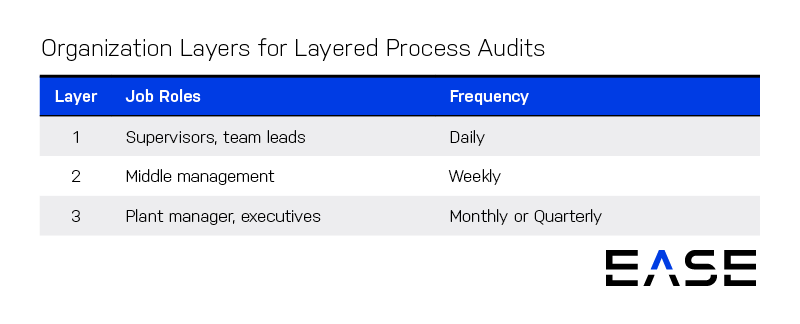5 Benefits of Layered Process Audits for Aerospace Suppliers


With only a handful of aerospace original equipment manufacturers (OEMs) as potential customers, aerospace suppliers have to hustle to make sure they’re selected. Stand out for the right reasons, and you could solidify 20 years worth of business. Make the wrong impression, and you could miss out on tens of millions (or more) in sales.
Taking a page from auto manufacturers, aerospace suppliers are increasingly adopting layered process audits (LPAs) as a way to build a competitive edge. LPAs help achieve many quality goals beyond cost and defect reduction, including one that can be hard to pin down: creating a culture of quality.
1. Reducing Defects in Aerospace Manufacturing
LPAs are a type of process audit conducted daily to standardize processes and reduce variation. What makes them unique is the multiple layers of personnel (including management) conducting the audits. The layers create a high frequency of audits, a best practice when you’re targeting big changes in quality.

The audits are short and fast, allowing organizations to add multiple levels of verification to high-risk processes. Correcting process errors early has a ripple effect that reduces defects, scrap and customer complaints downstream, driving dramatic results in as little as six months.
2. Creating a Culture of Quality in Aerospace
Some aerospace organizations treat quality as an administrative task, leading everyone to believe that quality is someone else’s job. Unfortunately, this is the polar opposite of a culture of quality.
LPAs help break down these barriers, laying the foundation for improving the quality culture, no matter what the current level of maturity of the quality culture of a business. LPAs help companies achieve this growth through:
- Cross-functional collaboration: LPAs leverage auditors from multiple departments that include engineering, operations, supply chain, logistics, etc. This makes quality part of the entire team’s daily responsibilities.
- Raising the visibility of quality: Conducting process audits multiple times each day keeps quality front and center as a priority. It also demonstrates a true commitment to quality, which is important given that it’s often forced to compete with production targets and other priorities.
- Reporting and accountability: LPAs provide a vast amount of data companies can use to build accountability into their systems. With a streamlined set of metrics, suppliers are better equipped to define expectations, track progress and communicate results.
3. Solving Problems Faster
LPAs provide increased visibility into shop floor processes, helping aerospace organizations solve problems faster by:
- Providing more opportunities than traditional audits to correct errors
- Getting to the source of defects by focusing on process inputs (instead of just finished outputs)
- Generating sufficient data for developing leading indicators, which are metrics that track with lagging indicators (for example, higher audit completion rates often correspond with higher yield)

Faster problem solving is only possible if you’re addressing non-conformances in a timely manner, which can be problematic with manual checklist entry. It’s why companies that start with paper-based audits often switch to an automated LPA platform to accelerate results.
4. Supporting Process Excellence
Part of what makes LPAs so effective is that they align with process excellence methodologies like Lean and Six Sigma. Examples include:
- Reduced waste and inefficiency: Cutting defects and improving processes means less scrap and rework.
- Process standardization: Checking high-risk processes every shift means you’re constantly reducing variation that causes defects.
- Continuous improvement: LPAs align with the plan-do-check-act process, including identifying weak spots, analyzing performance and correcting problems.
- Discipline: LPAs are a long-term strategy requiring daily participation in quality.
- Sustaining the gains: Adding questions linked back to corrective actions helps keep people from slipping back into old ways.
5. Verifying Regulatory and AS9100 Compliance
Just like LPAs dovetail with leading quality management approaches, they are also easily adaptable to a variety of audit types. This includes audits to verify compliance with regulatory requirements as well as standards such as ISO 9001 and AS9100.
It’s as simple as adding audit questions based on requirements, such as items that have been missed in the past or issues you identify in a gap analysis. Rotating and randomizing questions are best practices for protecting data integrity so people can’t just check the box.
Reducing defects, accelerating process improvement and creating a culture of quality all benefit aerospace suppliers, but they also benefit their customers. A well-run LPA system is a fast way to make a positive impression, creating trust to strengthen the OEM-supplier relationship as a whole.